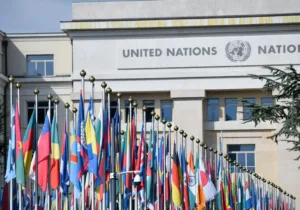Whatever the economic and military capacity of the United States, even the walk-and-chew-gum advocates—those who insist we can pursue a strategy capable of deterring and, if necessary, defeating both China and Russia at the same time—know there’s little chance we can do so alone. The U.S. must actively lead its allies—in Europe and the Indo-Pacific most specifically—to leverage their strengths and increase their own capacities, even as the U.S. leads the alliance. The strength of the wolf is the pack.
Alliances—and the allies that go with them—have perhaps fallen out of favor of late. Fingers will be quick to point to President Trump as taking the lead in putting American treaty allies in the crosshairs. He famously—infamously even—declared NATO obsolete, he hinted that certain allies—South Korea and Japan among them—ought to perhaps be encouraged to develop nuclear weapons of their own so that the U.S. could begin to collapse its umbrella protections, he chastised allies for not spending more on defense—and, not incidentally, thereby failing in their own treaty obligations, and he refused to explicitly affirm America’s Article 5 commitment while attending his first NATO summit. To certain degrees he walked much of this back over time, but the hesitance to be entangled by obligations that might be harmful to his strident “America First!” assertions remained.
But while Trump might have dressed down U.S. allies in a more Trumpian manner than most, he was by no means the first U.S. political leader to express skepticism over U.S. relationships with our allies. President Obama complained about allies not pulling a sufficiently amount of their own weight, as did Robert Gates as well as President Eisenhower before them. No one likes to be played for a sucker and Americans have never been eager to be entrapped in one-sided relationships in which a guileless America bears all the costs while free-riding allies derive all the unearned benefits. Owing at least in part, therefore, to this disdain for being taken advantage of, it’s probably true that to many American observers the risks and costs associated with military alliances are simply more visible and obvious than the benefits—it’s easier to notice what you’re sensitive to.
To be fair, it’s not as if there’s nothing to all this. As Elbridge Colby rightly warns, “U.S. alliances should exist not primarily as expressions of national altruism and largesse, but as ways of advancing America’s own interests.” Certain alliances, Colby observes, can cease to make sense. When they do, then in all likelihood they should simply cease altogether. That said, Colby continues:
But the truth is that sustaining alliances in North America, Europe and maritime Asia does advance U.S. interests—even when looked at from a hard-nosed businessman’s point of view. The reality is that U.S. alliances have served and continue to serve as an enduring source of strategic advantage and leverage—and ultimately, added security—for America. Indeed, Washington’s network of pacts is the envy of America’s rivals. Its main strategic competitors would trade places with us because they recognize and value what many alliance naysayers increasingly discount: America’s web of foreign security relationships is a source of power and influence in the world. And in particular, America’s rivals understand that U.S. alliances have foreclosed their expansion or reassertion of spheres of influence through the use of military force.
So even while free riding has hazardous implications—for it means our allies are less capable of contributing to collective defense operations or other interventions—the alliance that enables it can still be worthwhile. Indeed, free riding can in certain cases be a feature, rather than a mere bug, of American alliances. While the need for our allies to be able to contribute appropriately to operations is critical, a world in which our allies practice restraint in their military spending is one in which the U.S. has a greater degree of influence over those allies. Defense spending in general, therefore, can be seen in the same way as nuclear non-proliferation. The spread of nuclear weapons—even among our friends—dilutes American influence. To say nothing of adding to the dangers of a potentially less stable world.
There are limits to this, of course. But the point remains that the U.S. is better positioned to shape global affairs when allied with like-minded friends that at once both depend on us and can help support our interests in key regions than we would be without those alliances. One of the basic geopolitical lessons of both the War to End All Wars and of the one that came right after it is that the U.S. ought not to allow any adversarial power to dominate a critical geopolitical region—or, well, possibly any. This might mean that the U.S. is compelled to fight in order to protect regions such as Europe, East Asia, or the Middle East. When we are, it is clearly better to have powerful friends than not. To defer to Colby again:
Alliances allow the United States to agglomerate the power and wealth of affinitive states (or at least those sharing similar fears) for common, broadly liberal purposes, while locking out rivals which could otherwise leverage that same power and wealth, probably for illiberal ends.
Alliances, properly managed, also significantly increase the military power that the U.S. can bring to bear on a battlefield. This has proved true throughout the Cold War and in the years after 9/11. While the value of alliances post 9/11 might seem less significant, this is largely due to the power asymmetries between the U.S. and those we’ve been fighting. But we mustn’t overstate the case. During the Persian Gulf War, France and the United Kingdom provided major contributions to the primarily U.S. effort. NATO allies also contributed nearly half of the American-led Implementation Force mission that patrolled Bosnia in the mid ‘90s. Just so, U.S. allies played significant roles in Afghanistan, Iraq, Libya, and against ISIS. While it might not have been mission critical had such assistance not shown up, clearly America’s military burden—and the costs of carrying that burden—would have been significantly higher without allied contributions.
As Mathew Kroenig insists, this ability to punch above even our own robust weight will prove crucial in designing a defense strategy capable of deterring and, if needed, defeating both Russia and China in overlapping time frames. This punching power is backed by the fact that the U.S. and its formal treaty allies alone account for nearly 60% of global GDP. This economic might, Kroenig asserts, provides the resources to maintain a favorable balance of military power over China and Russia combined.
Taken together, the U.S. and her allies have the resources to design the needed strategy. Political theorists Hal Brands and Peter Feaver argue that this ought to include leveraging and even creating specialized capabilities among our allies. Sometimes, this specialized capability is material, taking the form of the particular capabilities of allied nations’ special operations forces, or of specialized platform capabilities—such as the Japanese’ particularly fine antisubmarine capability. More often, as Brand and Feaver observe:
More often US allies contribute geographical capability in the form of proximity to the theater of interest. This proximity allows forward staging of the strike and intelligence assets, particularly air assets, on which the American way of war depends. It also allows for specialized technical intelligence collection that would be nearly impossible to conduct without local partners. The counter-ISIS campaign, for instance, would have been vastly more difficult had the United States not had access to key facilities controlled by either treaty allies (Turkey) or long-standing military partners (Qatar or Bahrain).
This specialization—both material and geographical—allows critical points of focus. For example, European allies, Kroenig suggests, should invest in armor and artillery while Asian allies ought to buy naval mines, harpoon missiles, submarines, and the like. Following these mission-specific emphases, the US Army should focus on cooperation with its European allies while the Navy and Marine Corps would concentrate in the Asia-Pacific. The Air Force, meanwhile, would cover both theatres.
A final point. Many observers have cautioned that the war in Ukraine has revealed deficiencies in the U.S. defense industrial base that will prevent the American military from maintaining sufficient levels of munitions and platforms for an extended fight. Alliances are not worth much if they do not have the materiel for the fight. Now is the time for the defense industry to step up and revitalize its ability to keep America well equipped in the necessary fight—with large numbers of munitions, platforms, hardware, and emerging capabilities suited to both the traditional and new domains of warfare. Kroenig argues that Washington should signal to the defense industry that the country will increase procurement of key munitions and emerging technologies needed to fight adversaries like China and Russia so that the industry can make the long-term investments—now—that will be needed to boost production capacity for a for a wartime footing. Kroenig helpfully points to The Atlantic Council’s Commission on Innovation Adoption, which has released an interim report outlining ten recommendations that would enable the U.S. defense industrial ecosystem to better respond to the mission critical demands of strategic competition. One of the key recommendations is simply to successfully incentivize tech companies to do business with the Department of Defense. Internal allies across the private sector will prove just as critical as external allies. America must be one.
This vision of a unified America is essential. Yes, U.S. allies do need to properly fund and maintain their own defense and to project and deploy power in meeting shared interests across the globe. But they won’t do it if the U.S. doesn’t take the clear and unequivocal lead. The two-front fight that threatens on the horizon will overwhelm the free world if the U.S. is not united in its willingness to continue to shoulder the burden of leading that free world. No other like-minded nation is strong enough to replace the U.S. in this. Against hegemonic aspirants like China and Russia, who are not like-minded, only the U.S. can overmatch them, thwart those aspirations, and encourage allies to balance against them. Without American alliance leadership, Colby warns, “the calculations of states under the shadow of Chinese and Russian power would be considerably different…bandwagoning and accommodation become more compelling.”
For all of this to work, the U.S. must continue to build its own capacities—including by increasing intelligent defense spending—to deter and defeat both Russia and China. America must be credible both so that our would-be allies believe allying with us is wise and beneficial and so that our would-be adversaries believe that challenging us is unwise and harmful. Both Providence and ambition have allowed the US to gather to itself vast stores of power and security. This is not simply the result of having friendly neighbors above and below and two vast oceans to either side. It has been a choice. And it is a choice, too, that we have not simply horded this power to our own good. America, for all her ills, has chosen to be a force for good in the world. We must continue to make those same choices in order to continue to be that same force.
The strength of the pack is the wolf.







 Sponsor a student for Christianity & National Security 2024
Sponsor a student for Christianity & National Security 2024